Film Name:蜘蛛侠:英雄远征 / Spider-Man: Far from Home
Even though I never bought into Marvel’s “teaser-bait” tactics from the start and approached the film with a measured, composed mindset, Spider-Man: Far from Home still delivered a powerful lesson through its sheer excellence: Spider-Man movies—Marvel movies—can be made like this.
Now I finally understand why Kevin Feige declared this the true finale of Marvel’s Phase Three—because it anchors the heart that soared with Avengers: Endgame.

“Spider-Man: Far from Home” features a strikingly prominent core conflict and thematic style, while also being rich in genre elements—no matter your expectations or level of fandom, you’ll find something to enjoy in this film.
Moreover, the two surreal action sequences between Spider-Man and his adversaries showcased potential worthy of being called legendary.
[Friendly reminder: Spoilers ahead.]
As an MCU film, “Far from Home” not only seamlessly connects to “Avengers: Endgame” but also shoulders the crucial responsibility of concluding Phase Three. Consequently, it must clearly establish certain background knowledge and plot points (including Easter eggs).
In my view, “Far from Home” executes these “mandatory elements” exceptionally well: the opening campus news segment pays tribute to departed Avengers heroes, while the stadium chaos introduces the concept of the Blip. Later, Aunt May and Peter even attend a fundraiser for the “Blip survivors”…

As early as the release of Avengers: Endgame, many viewers wondered, “What would happen if half the people suddenly reappeared five years later?” The joke about poor Mr. Harington’s wife “disappearing for real but actually running away” struck a chord with quite a few netizens.
If Endgame declared “victory” with a collective climax, then Far from Home uses countless fragments of daily life to show “life” returning to earth.
Of course, this film is fundamentally a Spider-Man solo outing. Driven by the powerful dual engines of “teen drama” and “heroic adventure,” it unleashes a captivating charm that feels both familiar and refreshing.
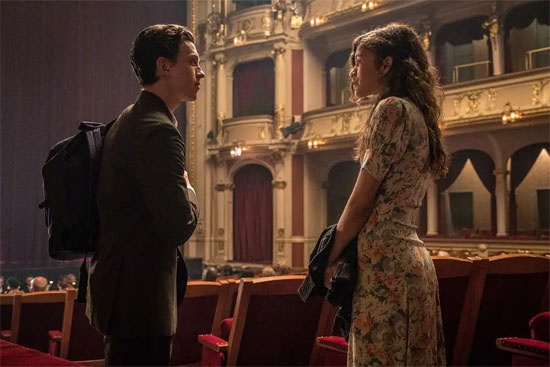
The film’s primary storyline is straightforward: Peter plans to confess his feelings to his crush MJ during everyone’s European study trip—a rather “cliché” trope from teen romance films.
Though seemingly unremarkable, this thread sets a lighthearted, youthful tone. It preserves the original spirit of the “new Spider-Man” while subtly enhancing other elements (and Zendaya is even more captivating here—love it!).
The other main plotline involves Nick Fury hijacking the study trip, with various factions and Mysterio making their appearances. It follows Spider-Man’s journey of discerning true enemies from false ones and growing through pain.
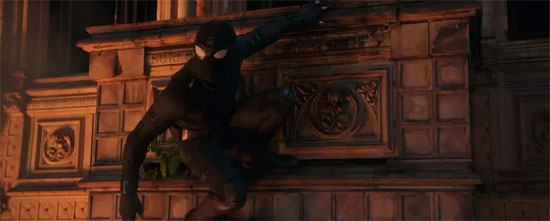
On its own, this storyline doesn’t seem particularly remarkable—new villains, new heroes, Fury and Hill running around tirelessly, Spider-Man sharpening his eyes to root out evil…
But when both storylines converge, “Far from Home” instantly bursts with vitality and freshness—Peter’s inner turmoil isn’t just the confusion of an ordinary teenager, but also the bewilderment of a newly minted superhero. This duality inherently possesses the potential for “1+1>2.”
Moreover, Peter’s troubles carry deeper layers of complexity and sorrow. No matter what, he cannot escape the shadow of Tony’s sacrifice and the weight of his expectations.
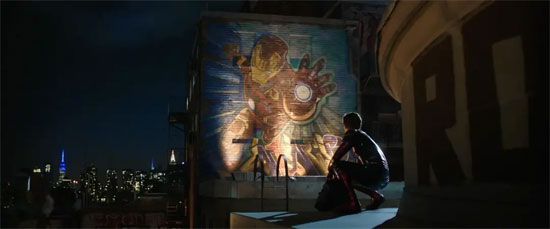
Wanting to become an Avenger was one thing; suddenly becoming Iron Man’s successor was quite another.
Peter finds himself once again grappling with the “superhero dilemma,” only this time it’s far more brutal and painful. He doesn’t want this heavy responsibility; he fears messing up and failing to live up to expectations. This leads to his avoidance tactics: ignoring Fury’s calls, leaving his Spider-suit behind during his study abroad trip, and passing the burden onto Mysterio.
To seamlessly weave these two storylines together, the film employs a key symbolic device: the smart glasses “E.D.I.T.H.” that Tony bequeathed to Peter.
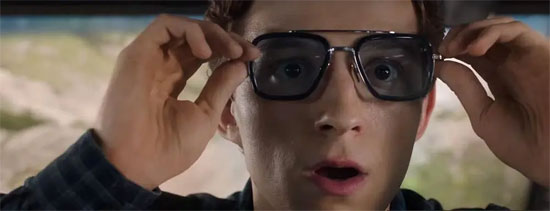
The powerful E.D.I.T.H. represents the culmination of Tony Stark’s technological prowess and financial resources—a rich legacy and a precious gift imbued with his affection and hopes for Peter. It symbolizes the passing of the torch between heroes.
Yet when Peter first receives the glasses, he causes a series of comically inept mishaps—repeatedly using a cannon to swat a fly (like deleting Brad’s phone photos and nearly having drones kill Thompson)—drastically diminishing Edith’s perceived value… These small tricks are commonplace yet remarkably effective.
By the film’s mid-to-late stages, Edith takes on new significance: it becomes a badge of responsibility for the Avengers’ succession, a lethal weapon capable of launching precision strikes worldwide.
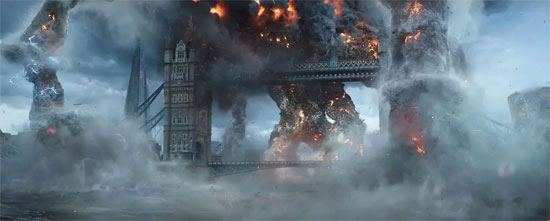
Quentin Beck was once merely a master of special effects, but with Edith, he not only upgraded his “illusion” capabilities but also gained the destructive power to inflict mass casualties.
Incidentally, filming “Far from Home” in Europe was a definite plus. From Italy’s water city to Prague’s squares, Berlin’s skyscrapers, Holland’s flower fields, and London’s Tower Bridge—the traditional mix of sightseeing and landmark destruction still felt fresh in the Marvel cinematic universe.
By the film’s conclusion, both storylines reach satisfying resolutions: Peter and MJ share a kiss and embrace, their mutual affection confirmed, while Spider-Man confronts his identity and returns to the skyscrapers and streets he vows to protect.

In my view, the scene of Peter swinging through New York City with MJ carries significance no less profound than the iconic moment in the original Spider-Man 2 where Mary Jane dashes through the streets in her wedding dress for Peter. Both moments signify the maturation of a young hero and the unyielding romance between soulmates.
Additionally, there are many other standout features of “Far from Home” I haven’t elaborated on—like Peter building a suit with Tony Stark’s determination, Happy’s warm and proud gaze, the “Shield Hammer” design paying homage to Captain America, and J.K. Simmons’s return as the journalist who’s always been a thorn in Spider-Man’s side. In short, whether you’re a nostalgia junkie, a nitpicky fanatic, or just here for the spectacle, this film has something to dazzle you.
Next, I’ll discuss my personal favorite part of the film: the Mysterio concept, the deceptively ambiguous action sequences, and the unique blend of reality and illusion that permeates the entire movie.
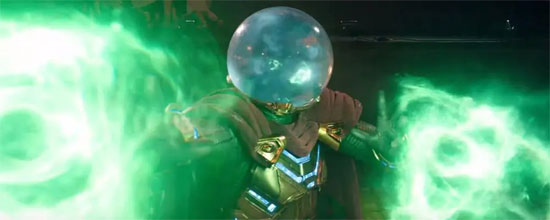
Quentin Beck and his tech team are perpetual runners-up living in the shadow of the prodigiously talented Tony Stark, lending the Mysterio villain a tragic aura. Their modus operandi isn’t mere destruction, but sophisticated deception masterfully executed through projections, acting, and clever tricks.
Even if you and I guessed Mysterio was the villain early on, Jake Gyllenhaal’s portrayal of Beck still delivers unexpected twists.
What I admire most in “Far from Home” are the two action sequences pitting Spider-Man against Mysterio. They push the boundaries of superhero movie combat, especially Spider-Man’s devastating defeat in their first clash in Berlin: Shifting illusions relentlessly target Peter’s deepest fears and demons, blending psychological manipulation with physical assault. The interplay of illusion and reality, the intricate layering, and the fluid choreography are utterly breathtaking. Personally, I believe its groundbreaking significance rivals last year’s “Spider-Man: Into the Spider-Verse.” This sequence alone makes a second viewing worthwhile.
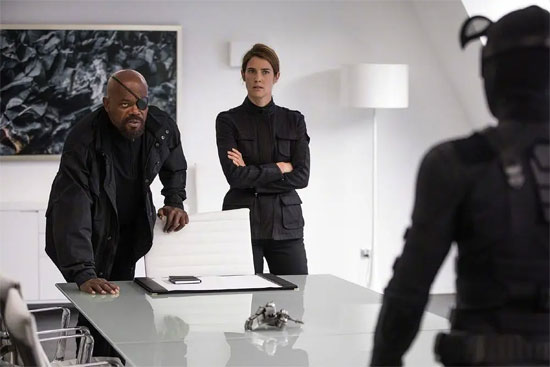
In the film’s first post-credits scene, a video distorting the truth and twisting facts is released. Combined with Quentin’s dying words—”People will believe anything” (roughly paraphrased)—the entire film gains immense depth and intellectual resonance.
Even more jaw-dropping is the second post-credits scene: Fury and Hill are actually the Skrulls Talos and Talos posing as themselves. Regardless of when the real directors were replaced, throughout this film, Fury has always been Talos. “Far from Home” maintains another illusion from start to finish, further elevating the film’s signature “reality-blurring” style.
In other words, both post-credits scenes not only deliver crucial MCU revelations but also serve as masterful finishing touches that elevate the film’s overall completeness!

“Spider-Man: Far from Home” delivers on all fronts while surprising audiences with unexpected delights throughout. Such a fine film deserves our praise.
The “post-Avengers” era has begun, promising excitement both on Earth and beyond. With Spider-Man performing so brilliantly, what reason do we have not to anticipate Marvel’s next phase?
Please specify:Anime Phone Cases » Spider-Man: Far from Home 蜘蛛俠:英雄遠徵 2019 Film Review: A Delightfully Endless Fantasy Medley